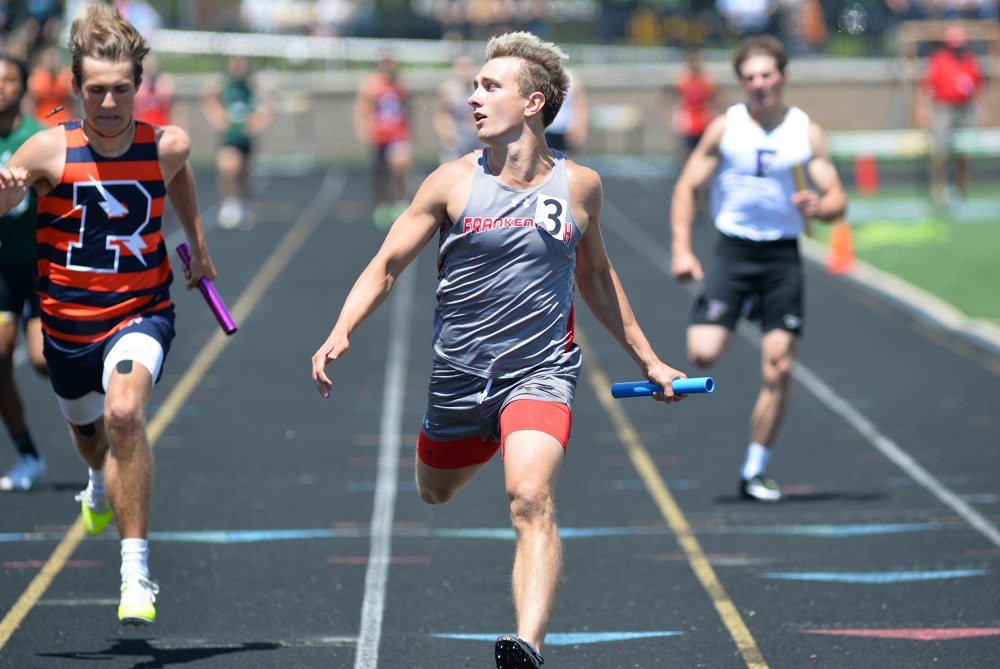
Frankenmuth Takes Championship Surge Through Final Race
June 5, 2021
ZEELAND – The Frankenmuth boys track & field team knew it had a chance Saturday to win its first MHSAA Finals championship since 2011 – but only if everything went right.
Not everything did – but plenty went better than planned as the Eagles won for the first time in Lower Peninsula Division 2, outpacing runner-up Flint Powers Catholic by 3¾ points to add a third championship to those won in Division 3 in 2005 and 2011.
Frankenmuth’s power in relays paid off in the final event, as the Eagles finished second in the 1,600 relay to Yale, scoring eight points while Powers came in eighth to add only one point to its team total.
That runner-up finish matched another in the 800 relay, and Frankenmuth also won the 400 relay with senior Daniel Barger joining junior Ian Stephens and sophomores Sam Barger and Andrew Braman. Those four ran the 800 together as well, with senior Ryan Brenner and junior Seth Malmo joining Sam Barger and Stephens on the 1,600.
 “We knew it came down to the mile relay, and I was pretty easy going the entire time – and then the mile relay hits and we knew Powers had to do something and we knew we had to do something, and I had to be alone for a little while,” Frankenmuth coach Luke Sheppard said. “I just had to sit and soak it all in, but it was a lot of fun – it’s a lot of fun to watch these kids run. They always compete. They always do what they’re supposed to.”
“We knew it came down to the mile relay, and I was pretty easy going the entire time – and then the mile relay hits and we knew Powers had to do something and we knew we had to do something, and I had to be alone for a little while,” Frankenmuth coach Luke Sheppard said. “I just had to sit and soak it all in, but it was a lot of fun – it’s a lot of fun to watch these kids run. They always compete. They always do what they’re supposed to.”
The Eagles’ lone win came in the 400 relay, but they picked up other points throughout the day in the 100 and 200 dashes, 300 hurdles, high jump and discus.
Powers, meanwhile, got a first in the 100 and third in the 200 from junior Austin Hamlin and placed in all four relays among a variety of scoring performances.
Powers had entered seeded first in the 400 relay and Frankenmuth third based on Regional times, but the Eagles crossed the finish line 41 hundredths of a second faster than the runner-up Chargers.
“We always know coming into meets we’ve got to up-seed – be better than what we’re seeded, be better than what we’ve been doing,” said Brenner, who in addition to his 1,600 relay leg contributed a sixth place in the 300 hurdles and seventh in high jump. “That was our mindset through this whole meet, knowing we had to perform at the best of our capabilities to do what we just did.”
Motivation was not in short supply anywhere this weekend, or throughout the season, after COVID-19 led to 2020 spring sports being canceled.
Fremont senior Nathan Walker capped his senior year Saturday by adding wins in the 1,600 (4:16.12) and 3,200 (9:34.30) to the cross country championship he earned in the fall. Edwardsburg junior Luke Stowasser also was a double champion in Division 2, claiming the long jump in 21-10 and high jump in 6-6 after also winning the former two years ago as a freshman.
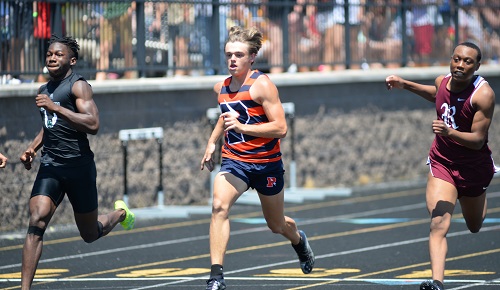 Hudsonville junior Ryan Shinabery edged Monroe Jefferson junior Alex Mansfield by 15 inches to win the discus with a toss of 163-7, but Mansfield won the shot put by more than eight feet ahead of the field with a toss of 59-2½. Allendale junior Cam Battjes rounded out the field event champions with a pole vault of 14-4.
Hudsonville junior Ryan Shinabery edged Monroe Jefferson junior Alex Mansfield by 15 inches to win the discus with a toss of 163-7, but Mansfield won the shot put by more than eight feet ahead of the field with a toss of 59-2½. Allendale junior Cam Battjes rounded out the field event champions with a pole vault of 14-4.
Romulus junior Troy Cranford won the 200 in 22.84, pacing a race where the top three finishers were separated by a tenth of a second – after he was third and Berrien Springs junior Jamal Hailey second to Hamlin in a 100 decided by less than two hundredths of a second between those three. Orchard Lake St. Mary’s senior Edward Watkins won the 400 in 49.1 seconds, and Marysville senior Evan Woodard won the 800 in 1:55.25. Allendale junior Patrick Adams won the 110 hurdles in 15.19 seconds, then finished second in the 300 as Vicksburg senior Levi Thomas edged him in 40.10.
Fruitport won the 800 relay in 1:29.64, while Yale won the 1,600 in 3:25.85 and Holland Christian won the 3,200 relay by less than a second, in 8:01.26.
PHOTOS: (Top) Frankenmuth’s Daniel Barger, middle, crosses first in a close 400 relay finish Saturday. (Middle) Fremont’s Nathan Walker finishes one of his two championship runs. (Below) Flint Powers Catholic’s Austin Hamlin, middle, edges Jamal Hailey of Berrien Springs (far left) and Romulus’ Troy Cranford in the 100. (Photos by Dave McCauley/RunMichigan.com.)
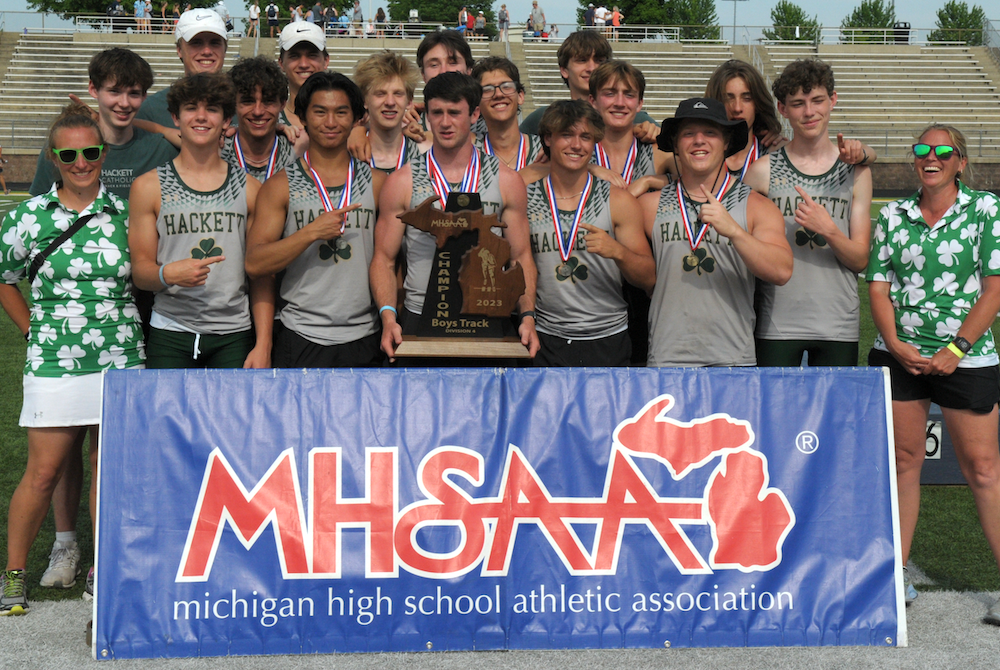
Thrower Claims Lone Individual Title to Lead Hackett to Team 3-Peat
By
Tom Lang
Special for MHSAA.com
June 3, 2023
Kalamazoo Hackett Catholic Prep just keeps winning and winning.
This time the Irish took home their fourth title in the last five Lower Peninsula Division 4 Track & Field Finals, on Saturday at Hudsonville.
Hackett’s only individual title was taken by discus winner Nathan Buchmann, a senior, who was fine knowing he was the shortest in stature among all the sizable competitors.
“In the offseason after football I worked out every day, working towards this goal,” he said after getting his medal. “I would say this takes 80 percent technique and 20 percent strength to throw the discus. So, length can help but if you have good technique and are really strong, that will play into it.
“I think we are very balanced throughout the meet today,” he said about teammates that scored points in finishes other than first place. “We have 13 guys here today, and we have people in a lot of the races. But I do not run; I have too short of legs to be a fast runner,” he said with a chuckle.
Buchmann had to work through a hip injury to compete this spring.
“I think the setbacks are what make you strong,” he said. “You can either give up through the setbacks or push forward and become better.”
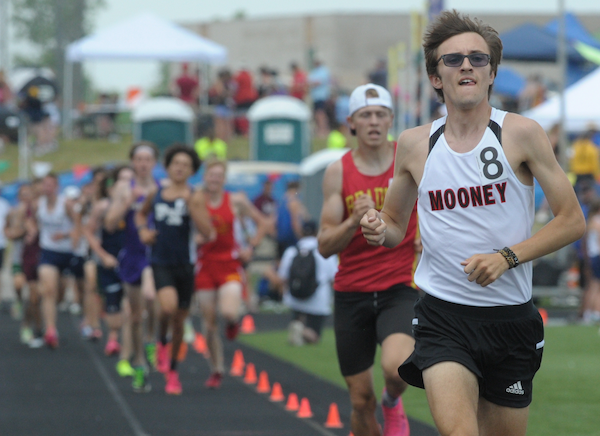 Coach Charissa Dean agreed.
Coach Charissa Dean agreed.
“The kids have big hearts,” she said after all the points were totaled and the Irish were on top once again, with 53. “They worked hard. They had a lot of potential when we started the season. And we had a lot of drive to put in the work, and we are happy the results came out the way they did.”
Reading was runner-up at 47 points, followed by Wyoming Potter’s House Christian with 42, then Fowler and Flint Beecher each with 37 points.
Senior Lezawe “Moses” Osterink, of Potter’s House Christian, placed second in 1,600 but took the 3,200 title as defending champ of both. He dominated the latter by lapping the field with a final lap kick that resembled more of a superhero speedster.
“Nobody really took it out that hard at the start,” he said. “There was a freshman (Marek Butkiewicz of Hackett) that tried to get the pace going quick, but me and Dakota (Dykhuis of Montabella) just kind of sat back and gradually pulled him through.
“We took it gradually, and I was just relying that I could kick.”
Kick did he ever. The trio were neck and neck the majority of the race in a grouping ahead of the pack.
“With 400 to go I just tried to go all out,” Osterink said. “I had a lot more left than I thought and I was pleased with the win. Not really the time, but that doesn’t matter, especially this hot out.”
The overall meet was in the low 90s/high 80s heat and searing sun all day. So, race officials allowed the unique opportunity for coaches to spray the runners with water and give them water bottles.
“It was very weird because I’ve never taken water to drink while I’m running, so I didn’t know how that would feel,” Osterink said. “And they were spraying us and hitting us in the face. It was kind of fun.”
Junior Tyler Lenn of Marine City Cardinal Mooney defeated Osterink at his own game in the 1,600.
“I’m feeling great,” Lenn said after grabbing the medal. “I said to a newspaper after one of my races (during the season) I was right where I wanted to be. This has been a long rebuilding process for me since an injury back in the fall, and I set a pretty high goal the day the injury happened. I was telling myself I needed to fulfill what I said I would do at the beginning of last cross country season. And that is what I did today.”
Lenn suffered an ankle sprain from a misstep that turned worse because he kept running through the season on it.
“Coming back from that was pretty tough, but I wouldn’t have it any other way,” he said. 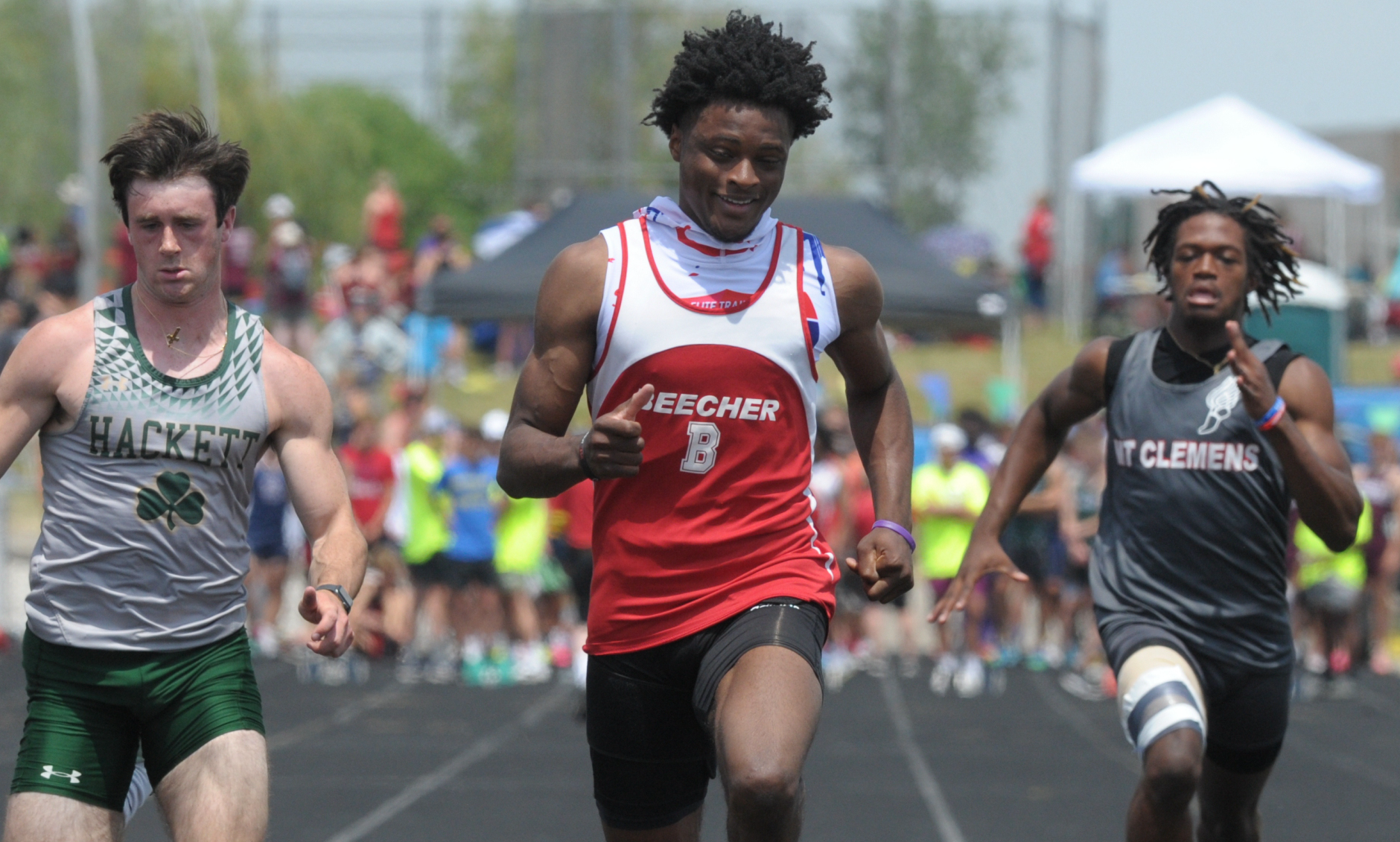 “Perseverance; I said from the beginning what I was going to do. I kept my eye on that target, and no matter the circumstances life threw at me, that I was going to make it happen and I am a man of my word.”
“Perseverance; I said from the beginning what I was going to do. I kept my eye on that target, and no matter the circumstances life threw at me, that I was going to make it happen and I am a man of my word.”
Jaylin Townsend, a senior from Flint Beecher, dominated the short races. He won the 100 dash (10.67) and 200 dash at 22 seconds flat. It was his third 100 win at a Finals.
“I put in a lot of work; I had to three-peat,” he said after the 100. “There’s a lot of great competition here, so I knew I had to come out and run my best.”
Concord in the 400 (43.72), Buckley in the 800 (1:30.76) and 1,600 (3:29.13) and Potter’s House in the 3,200 (8:14.18) were relay champs Saturday. Reading’s Tayshawn Bester won the 110 hurdles (15.13), and Athens’ Landen Bennett won the 300 (39.85). Caseville’s Nathan Feltner won the 400 (50.76), and Vestaburg’s Owen Patton claimed the 800 (1:55.11).
Fruitport Calvary Christian’s Bradley Richards won the high jump (6-10), and Peck’s Alex Affer won the long jump (23-4). McBain Northern Michigan Christian’s Isaac Bowden was first in pole vault (13-0), and Brown City’s Kyle Affer won shot put (49-2).
PHOTOS (Top) Kalamazoo Hackett Catholic Prep celebrates its third-straight LPD4 title Saturday. (Middle) Cardinal Mooney's Tyler Lenn, far right, sets the pace in the 1,600. (Below) Flint Beecher's Jaylin Townsend, middle, crosses the finish first for one of his two sprint championships. (Photos by Ken Swart/RunMichigan.com.)

